Grammarly Vs. Hemingway: A Skilled Author’s Overview
Can book writing software replace an editor? Nope. But it can help you improve your grammar and readability.
You were born to tell stories and share your message with the world. But you sit down to type and something terrible happens. Your fingers misspell things. Verbs switch tenses as you type. Nothing works quite like it did when it was still just a compelling idea in your head.
You reread and catch a few grammatical errors, but what if you’ve reached the end of your grammar prowess? Can some book writing software help improve your writing? Take a look at this online editor and readability app and see if one or both of them will work for you. Let’s see how Grammarly vs Hemingway stack up.
Best Book Writing Software: The Magic of Grammarly vs Hemingway App
My high schoolers are just beginning their journey as writers. They can’t always wait for me to wave my special English teacher green grammar pen over each piece of writing. I like for them to have access to editing tools and grammar checkers outside of those offered in their word processing docs.
It’s not just for students though. We all make common errors like misspelling, verb tense problems, and comma misuse. Sometimes, our sentences are too long and hard to follow.
While I always recommend having an editor, there are times even as a professional writer, you just need a quick grammar tool to help polish a blog post or social media post or even find (and eliminate!) glaring grammar errors before sending something off to a reader or editor.
We can begin to fix these mistakes ourselves with a little help from some book writing software like Grammarly and Hemingway.
Getting Started With Grammarly
Grammarly is one of the first pieces of book writing software I introduce to my students. We still work on specific grammar skills (sorry, kids, still gotta learn them!), but Grammarly, even when used for its most basic features, can help students see patterns in their writing without my help.
For writers, this is an essential first step, since Grammarly catches errors that Word or Google Docs miss.
Grammarly’s free edition will mark most contextual spelling and some usage errors. Go to Grammarly.com. Open a free account and login. From there, you will see a grid where you can upload or copy and paste in writing.
Once you have attached or pasted in the words, watch for the little green rotating circle at the bottom. It’s working grammar magic! When complete, it underlines suggestions.
Yin addition to the desktop app. you can also download the browser extension, and it will run in the background on most everything. Most of my students don’t love having it run all the time because it can slow down whatever they are working on.
Evaluate the Suggestions
As I tell my students, don’t just accept all the suggestions. Look at them. Read the examples and evaluate if the suggestion is correct for the context. If the suggestion is correct or what you intended, you can click on the green correction, and it will make the change. If not, click “ignore.”
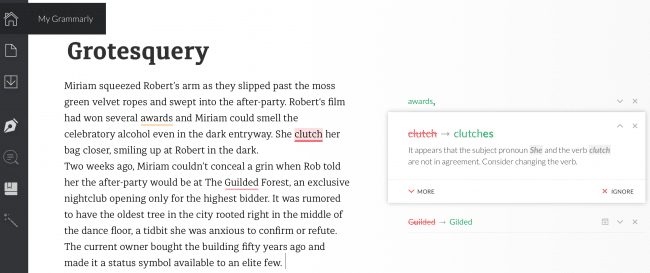
Notice how it suggests “clutches” for “clutch.” I would need to change it to the past tense “clutched” to remain in past tense with the rest of my story.
The other thing I tell students: read the rules it offers. Most suggestions will state the grammar rule. Click on the “more” box and read the rule and examples. If you consistently see a rule popping up (like fragments), it’s worth taking the time to figure out why.
Level Up to Learn
If you upgrade to Grammarly premium, it offers a range of additional features like sentence structure, style, and vocabulary enhancement. The paid version is most affordable at the yearly level for $144 (which is far more than most of my students can afford or are willing to spend).
But in case you are curious, Hhere are the additional features, including a handy report feature.
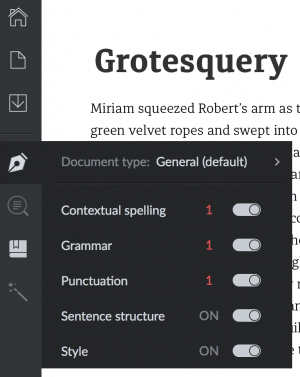
. 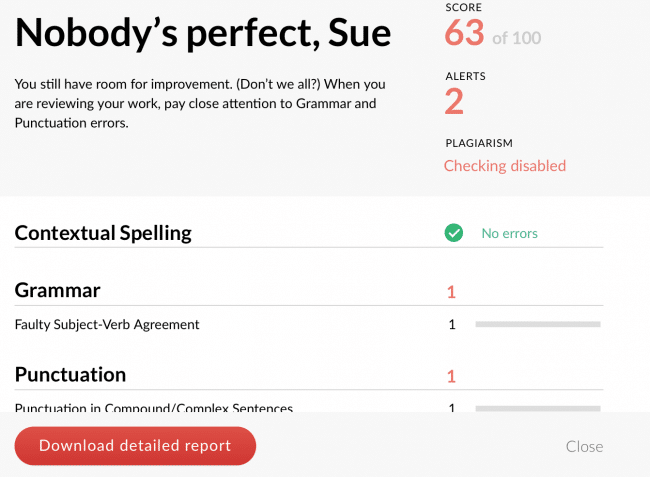
They offer a free week trial, but be aware, they charge the month when you sign up. You have to request a refund within one week. Still, for $30 a month, it would cost less than an hour of editing (proofreading) to evaluate if the paid version is giving you enough information to continue.
If you use the paid version, take the time to read through the suggestions and watch for patterns in your work. This is the real magic of Grammarly. Use it to learn where your writing can be improved and use that information to grow.
Again, it isn’t meant to replace a good editor, but it can help you clean up posts, scenes, and chapters before sending to an editor.
But what if your sentences are clean, but hard to read?
Improve Readability With Hemingway
The second piece of book writing software I suggest to students is Hemingway. Hemingway checks readability. What’s readability and why do I care?
Readability measures how easy writing is to read.
The Hemingway App takes its name from the American author Ernest Hemingway, known for his spare, direct style.
Most writers believe their sentences are easy to read (after all, I know exactly what I mean, right?). The problem is when your reader has a hard time following. Then what?
If the reader can’t follow the sentence to the end, they’ll stop reading. Readability makes a big difference for the reader, especially if it is an article or story posted online.
Getting Started With Hemingway
Go to Hemingwayapp.com. You’ll see a sample text already there. You can delete the text and paste your own. Then click “edit” in the top right hand corner. Hemingway is looking for adverbs, passive voice, and sentences as units.
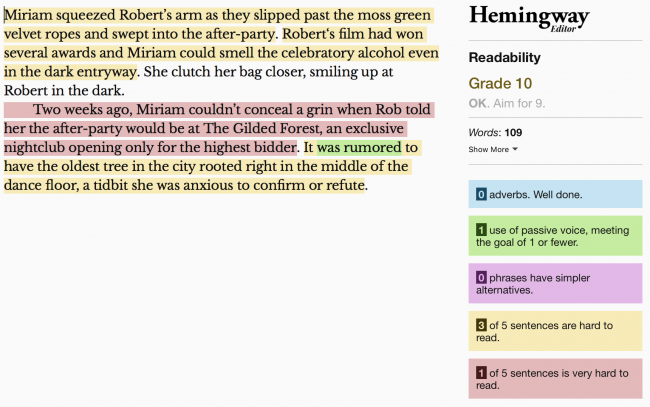
What’s wrong with adverbs?
Nothing, as long as they stay in the dictionary. Just kidding. The problem with adverbs is this: they often prop up weak verbs. Why say “walked quickly” when you could say “hustled.”
I don’t have to eliminate all adverbs, but I do want to make sure I’m not depending on them.
“
Overdependence on adverbs marks amateur writing.
(I wish I hadn’t learned this first-hand from an editor. Embarrassing.)
Hard-to-Read Sentences
This is my own personal nemesis. See all those sentences that are hard to read? It is because they are long and include multiple phrases or clauses.
They might be fine, depending on the reader and genre, but I need to consider the pattern. I want my reader to move through a sentence effortlessly—without calling attention to the words forming the sentences.
The Hemingway App isn’t trying to make me write like Hemingway, in only short, crisp sentences. It’s trying to help me see patterns in my writing skills that might make the reader work harder than needed.
If I’m writing a literary novel, then the difficulty might be part of the point, but in a quick blog post to help writers, those long complex sentences are getting in the way.
What’s With the Readability Score?
Notice that the short intro to a story pictured above has a grade 10 readability. Why is grade 9 better? Let me tell you a secret: Writing that is easy to read while conveying complex ideas is hard to write. Look at this excerpt from “Hills Like White Elephants” by Hemingway himself.
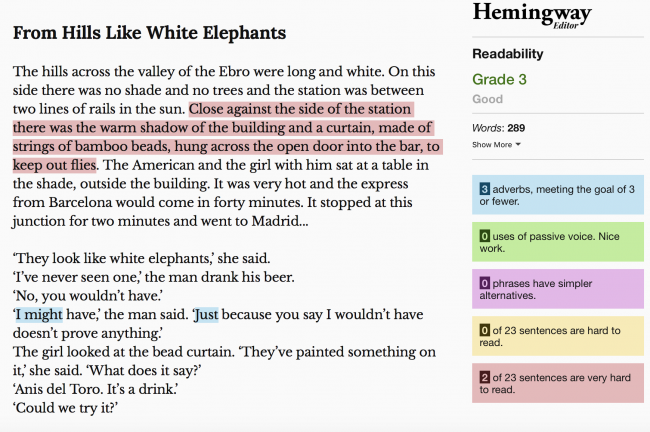
Grade 3 readability? This is a story about an American and his girlfriend at a crossroads in Spain, considering an abortion and the future of their relationship. It doesn’t mean this is a story for a 3rd grader. It means the language is so clear and straightforward, and 3rd grader could read it.
(Note: the opening paragraph by itself is a grade 7. It’s better to put in the full text for a more accurate reading. My guess is this full text is probably more around a 5th or 6th grade readability score.)
Hemingway (the writer) is famous for his spare, concise text that is easy to read like the example above. He’s equally famous for revising sentences until they were crystal clear. That commitment to clarity is what I need to learn from him.
Pop a section of your work in progress into the app and see what your text’s current writing level is. Then, start to notice patterns. Don’t make the mistake of thinking a higher reading level is always better. It isn’t.
What Readability Level Should I Be Writing?
If you want to know what grade level readability you should be shooting for, look to your genre. Take excerpts from a few of the top books in your genre and test the readability. It’s best to choose at least three passages (beginning, middle, and end).
Can you write outside the readability for your genre and still be successful? Probably. Might be worth checking and know why you are choosing to write outside those expectations, though, since it might cost you readers in the end.
Grammarly vs Hemingway: You’ll Still Need an Editor
I’m sure you noticed in the excerpts that there are still errors. Grammarly and Hemingway are useful, but even the best book writing software can’t replace a good editor.
“
Grammarly and Hemingway can’t replace a good editor, but they’re great ways to start revising.
Still, they are a good starting place for figuring out which grammar skills you might need to practice and for streamlining your sentences. Plus, they can save you time—time you can spend on more writing!
Looking for more tools to help you write better and faster? Check out this list of our Top 10 Pieces of Software for Writers!
Which apps do you like best for improving grammar and readability? Which one will you try first? Let us know in the comments.
PRACTICE
Today, it’s time to check your work.
Open a work in progress and download one of the free versions of either Grammarly or Hemingway. Copy and paste in your work. Then, take fifteen minutes to read through the suggestions and consider ways to edit the piece. What changes will you make? What do you learn from the analysis?
If you don’t have a current work in progress, take ten minutes to write a new story about a couple having a disagreement. Then, copy and paste your work into either Grammarly or Hemingway. Take five minutes to consider the suggestions and edit the piece.
When you’re done, share your “before” and “after” pieces in the practice box below, and be sure to leave feedback for your fellow writers!
Oops! We could not locate your form.
